
views
Using a Postage Calculator
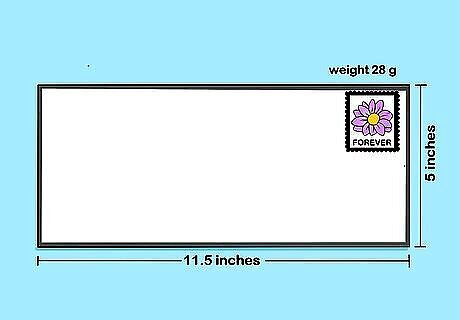
Use a Forever stamp for most standard mail items. A single Forever stamp will be enough to send off an item in a commercial envelope measuring 11.5 inches (29 cm) by 5 inches (13 cm) and weighing 1 ounce (28 g) or less. Anything larger will require extra postage, which you can add up using a postage calculator. The easiest way to go if you need specific postage is to use an online retailer to get the stamps you need. To purchase stamps online, go here. As of July 2023, the cost of a single Forever stamp is $0.66. Forever stamps are useful for mailing letters, greeting cards, and paper items weighing less than 1 ounce (28 g). To send a standard commercial envelope somewhere outside the United States, you’ll need to use a Global Forever stamp. At this time, Global Forever stamps cost $1.50 apiece.
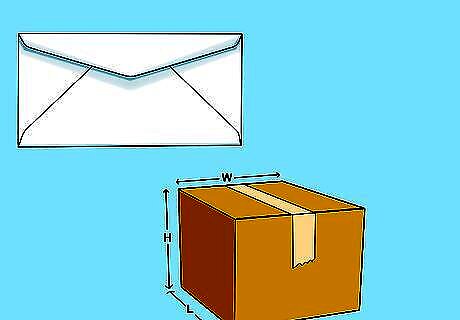
Measure envelopes or packages that are larger than standard size. Use a ruler or measuring tape to find the length and width of an envelope. For packages and bulkier envelopes, be sure to include the thickness along with the length and width. The overall size of the item will be used to determine the cost of postage. Take exact measurements just to be on the safe side. You can always round them up or down depending on the directions you’re given by the postage calculator. Stamps aren’t generally used for large packages, which will need to be shipped through the post office rather than being sent through the mail.
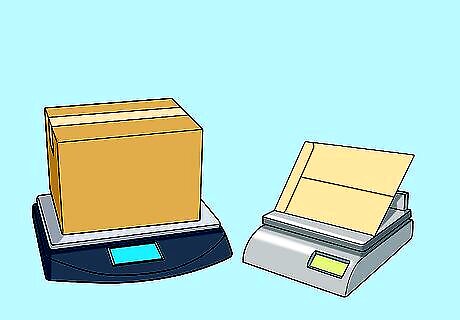
Weigh your envelope if you’ve included gifts, photos, or other extras. To do this, it will be necessary to use a scale sensitive enough to register the item’s weight in ounces or grams. Ordinary kitchen scales will work great for envelopes and small parcels. Heavier packages can be placed on a digital bathroom scale. Most postage calculators will ask you to round up the weight of the item when calculating the price of postage. If you don’t have access to a scale, take your item to the post office. They’ll be able to weigh and ship it for you.
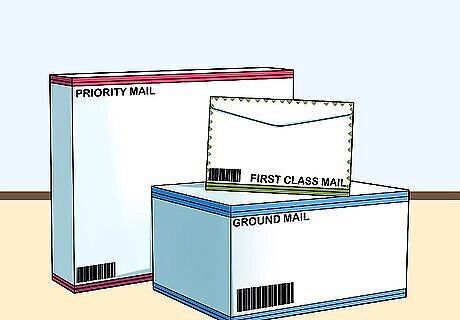
Specify the class of the item you’re mailing. There are 3 standard mail classes—Ground, Priority, and First Class. When deciding which class best suits your needs, consider both the weight of your item and how fast you need it to arrive at its destination. Items sent Ground mail (sometimes referred to as “standard shipping”) typically arrive within 2-8 business days. Ground is most useful for sending large quantities of mail at once, handling oversized packages, and saving money on things that aren't urgent. With Priority Mail, delivery is guaranteed within 1-3 days. To make sending large items more affordable, you have the option of mailing them in a flat rate envelope or box, which costs a fixed rate regardless of weight (up to 70 pounds (32 kg)). First Class mail also usually goes out in 1-3 days, but items are limited to 13 ounces (370 g) in weight. Heavier items will require additional postage.
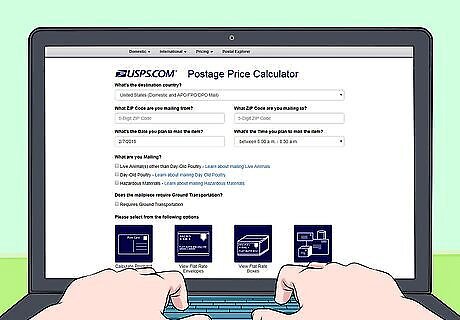
Plug the item’s information into a postage price calculator. In addition to the size, weight, and class of your envelope or package, you’ll be asked to enter its destination, the destination’s postal code, your postal code, and the time and date of shipment. After submitting your item’s info, you’ll be shown the mailing cost, which you can then use to figure out how many stamps you’ll need. If you live in the US, use the United States Postal Service’s (USPS) online postage price calculator by visiting this link: https://postcalc.usps.com/. Put in the item’s info as accurately as possible to make sure you’re paying the right postage.
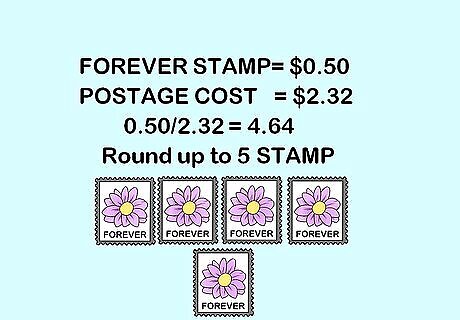
Divide the postage price by the price of a Forever stamp. The number you get is how many stamps you’ll need. If your postage cost comes to $2.64, for example, you would divide 2.64 by 0.66 to get 4. Therefore, you would need 4 stamps. Don’t forget to round up if necessary to ensure that you have enough postage, since it’s not possible to use a fraction of a stamp. Alternatively, you can purchase special stamps used to make up the difference of extra postage. Additional postage stamps are sold in smaller values, such as 1 cent, 2 cents, 3 cents, 5 cents, and 10 cents. You can find a variety of stamps online here.
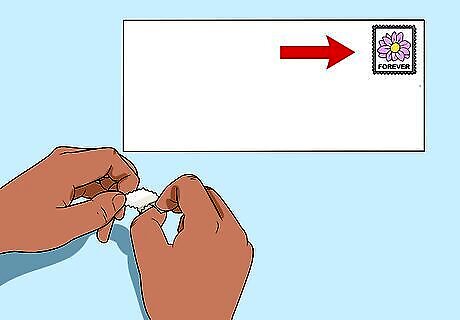
Apply your stamps. Peel the backing off the stamps and press them onto the envelope or package. If possible, position them in the upper righthand corner or somewhere else where they’ll be plainly visible to the mail handler. Arrange multiple stamps in 1 or 2 rows, making sure they don’t overlap. If you’re having trouble applying your stamps properly, take them to the post office and ask for assistance from one of the clerks there.
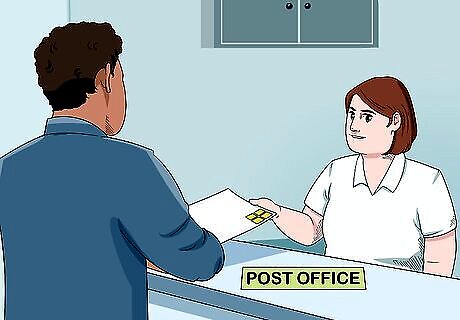
Take items requiring more than 1 stamp to the post office. Overstuffed envelopes, large packages, and anything else that weighs more than 13 ounces (370 g) can’t be mailed through a residential mailbox. You’ll need to take these items to the post office for shipping. Once you’re there, hand off your item directly to one of the employees on duty for processing. Postal clerks can also help you calculate the price of postage and sell you the required number of stamps right there at the post office. In many areas, the postal service will permit you to print out a shipping label and schedule a pickup from home if you’d prefer not to make a trip to the post office.
Calculating Postage at the Post Office

Bring the sealed item to the post office. Make sure that the flap holding the envelope or package closed is secure. Your item should be neatly addressed and free of extraneous information that might confuse the postal employees, such as old shipping labels or unnecessary writing. To save time, take care of stuffing, sealing, and addressing your item before you arrive. If you’re running low on supplies, you can also purchase mail accessories like envelopes, mailers, and stamps online here.

Have your item weighed. Tell one of the employees on duty that you need to know the weight of your item in order to calculate the correct postage. They’ll place it on the scale and give you a cost right there on the spot. The mail clerk may also request a few other pieces of information, such as your postal code, where the item is headed, and whether you want to send it Priority Mail or First Class. Priority mail typically arrives faster, but First Class mail is less expensive. Keep in mind, however, that you can only mail items First Class if they weigh 13 ounces (370 g) or less.
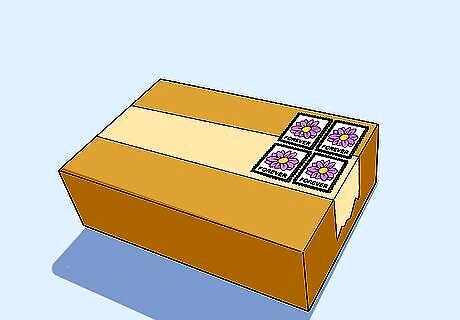
Apply the required number of stamps to your item. After affixing the stamps to your envelope or package, hand it over to the postal clerk. Since you’re already at the post office, you also have the option of simply paying for postage, in which case the clerk will print out and stick on a mailing label noting the item’s shipping cost. It will be cheaper to use your own stamps if you brought them along than to pay for postage separately. If you’re not sure how to convert your item’s postage price to the corresponding number of stamps, or you’d just rather not bother, the postal employee on duty will be happy to help.




















Comments
0 comment